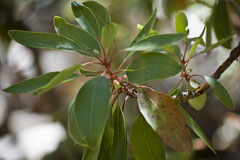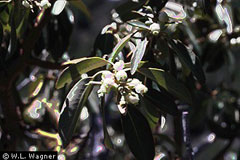 |
|
http://www.flickr.com/photos/15363357@N00/4770529 |
 |
| http://commons.wikimedia.org/wiki/User:Cillas |
Translate this page:
Summary
Arizona madrone is an evergreen shrub or small tree of the mountains of southern Arizona and New Mexico, reaching up to 15 meters tall. Its smooth, flaky red-brown bark and leathery lance-shaped leaves give it an elegant appearance. The fruits are reddish-orange to bright red, with bumpy skins and soft, white interiors.
Physical Characteristics

 Arbutus arizonica is an evergreen Tree growing to 15 m (49ft 3in) at a slow rate.
Arbutus arizonica is an evergreen Tree growing to 15 m (49ft 3in) at a slow rate.
See above for USDA hardiness. It is hardy to UK zone 6. It is in leaf all year, in flower in May, and the seeds ripen from October to November. The species is hermaphrodite (has both male and female organs) and is pollinated by Bees. The plant is self-fertile.
Suitable for: light (sandy) and medium (loamy) soils, prefers well-drained soil and can grow in nutritionally poor soil. Suitable pH: mildly acid soils. It can grow in semi-shade (light woodland) or no shade. It prefers dry or moist soil.
UK Hardiness Map
US Hardiness Map
Synonyms
Plant Habitats
Woodland Garden Canopy;
Edible Uses
Edible Parts: Fruit
Edible Uses:
The berries are edible fresh, though overconsumption may cause nausea or vomiting. Ripe fruits are pleasantly sweet with a bland aftertaste, containing about half flesh and half delicately crunchy seeds. Unlike manzanita, the seeds are soft and do not require removal, making them easy to process. Berries can be dried for flour or used to make cider, wine, or jelly. Unripe green fruits taste awful and should be avoided. Timing is crucial—fruits mature from July to October and often fall soon after ripening, sometimes littering the ground in a vibrant red carpet[2-3]. Fruit - raw. The fruit is about 8mm in diameter with a thin sweetish flesh[82].
References More on Edible Uses
Medicinal Uses
Plants For A Future can not take any responsibility for any adverse effects from the use of plants. Always seek advice from a professional before using a plant medicinally.
Astringent
The bitter principles in the bark and leaves can be used as an astringent[229].
References More on Medicinal Uses
The Bookshop: Edible Plant Books
Our Latest books on Perennial Plants For Food Forests and Permaculture Gardens in paperback or digital formats.

Edible Tropical Plants
Food Forest Plants for Hotter Conditions: 250+ Plants For Tropical Food Forests & Permaculture Gardens.
More

Edible Temperate Plants
Plants for Your Food Forest: 500 Plants for Temperate Food Forests & Permaculture Gardens.
More

More Books
PFAF have eight books available in paperback and digital formats. Browse the shop for more information.
Shop Now
Other Uses
Charcoal Wood
Wood - heavy, soft, close-grained, brittle[82]. It produces a fine grade of charcoal[229]. The fruits can be fermented or dried into a storable food. The tree’s red bark and evergreen foliage make it highly ornamental. Its fruit and flowers provide resources for wildlife, and traditional uses include making drinks such as cider.
Special Uses
References More on Other Uses
Cultivation details
Requires a lime-free nutrient-rich well-drained moisture-retentive soil in sun or semi-shade and shelter from cold drying winds, especially when young[200]. Succeeds in dry soils[82]. Plants are hardy to about -15°c[166, 200]. A slow-growing tree[229].
References Carbon Farming Information and Carbon Sequestration Information
Temperature Converter
Type a value in the Celsius field to convert the value to Fahrenheit:
Fahrenheit:
The PFAF Bookshop
Plants For A Future have a number of books available in paperback and digital form. Book titles include Edible Plants, Edible Perennials, Edible Trees,Edible Shrubs, Woodland Gardening, and Temperate Food Forest Plants. Our new book is Food Forest Plants For Hotter Conditions (Tropical and Sub-Tropical).
Shop Now
Plant Propagation
Seed - best surface sown in a cold frame as soon as it is ripe. Stored seed should be soaked for 5 - 6 days in warm water and then surface sown in a shady position in a greenhouse[78]. Do not allow the compost to become dry. 6 weeks cold stratification helps[134]. The seed usually germinates well in 2 - 3 months at 20°c[134]. Seedlings are prone to damp off[184], they are best transplanted to individual pots as soon as they are large enough to handle and should be kept well ventilated. Grow them on in a greenhouse for their first winter and then plant out in late spring after the last expected frosts[K]. Basal cuttings in late winter[200]. Cuttings of mature wood of the current season's growth, November/December in a frame. Poor percentage[78]. Layering of young wood - can take 2 years[1, 200].
Other Names
If available other names are mentioned here
Arizona Madrone (Arbutus arizonica (A. Gray) Sarg.)
Native Range
NORTHERN AMERICA: United States (New Mexico (southwest), Arizona (southeast)), Mexico (Chihuahua, Durango, Sinaloa, Sonora, Zacatecas, Jalisco)
Weed Potential
Right plant wrong place. We are currently updating this section.
Please note that a plant may be invasive in one area but may not in your area so it's worth checking.
None. Restricted to natural habitats; not invasive.
Conservation Status
IUCN Red List of Threatened Plants Status :

Growth: S = slow M = medium F = fast. Soil: L = light (sandy) M = medium H = heavy (clay). pH: A = acid N = neutral B = basic (alkaline). Shade: F = full shade S = semi-shade N = no shade. Moisture: D = dry M = Moist We = wet Wa = water.
Now available:
Food Forest Plants for Mediterranean Conditions
350+ Perennial Plants For Mediterranean and Drier Food Forests and Permaculture Gardens.
[Paperback and eBook]
This is the third in Plants For A Future's series of plant guides for food forests tailored to
specific climate zones. Following volumes on temperate and tropical ecosystems, this book focuses
on species suited to Mediterranean conditions—regions with hot, dry summers and cool, wet winters,
often facing the added challenge of climate change.
Read More
Expert comment
Author
(A.Gray.)Sarg.
Botanical References
82200
Links / References
For a list of references used on this page please go here
Readers comment
| Add a comment |
|
If you have important information about this plant that may help other users please add a comment or link below. Only comments or links that are felt to be directly relevant to a plant will be included. If you think a comment/link or information contained on this page is inaccurate or misleading we would welcome your feedback at [email protected]. If you have questions about a plant please use the Forum on this website as we do not have the resources to answer questions ourselves.
* Please note: the comments by website users are not necessarily those held by PFAF and may give misleading or inaccurate information.
To leave a comment please Register or login here All comments need to be approved so will not appear immediately.
|
Subject : Arbutus arizonica
|
|
|
|